Russian original abstracts
Sakhalin marine researches & design facilities - XX age
3D tensor mathematics for the computational fluid mechanics
Mathematical and computational simulation of tidal and flow in Okhotsk sea
Compute aided system for duty oceanologist of the tsunami warning service
Navigator’s on board compute systems for the oil-rig steadfast and stability
Onboard seakeeping computer system
Storm seakeeping researching agreed the hull form and the ship architecture
Information complex for analysis of operative hydrometeorological environment at the sea
3D tensor mathematics for the computational fluid mechanics
The computational fluid mechanics experiments by using of a digital computers is based
on a finite differences schemes, which applied hydrodynamic values by nodes of computation
grid and the distance between item points is impossible to admit as infinitesimal ones, so
approximation of hydrodynamic fields of computational schemes are not smooth and not
continuous.
Designing of mathematical methods at the beginning oriented for solution to the fluid
mechanics of the finite differentials, allows not only to analyze correctly the
differential approximations properties for differential equations, but it is the
foundation for complex researches of fluid reology as well and it can be used for problem
establishment and practical realization of fluid mechanics computational experiments.
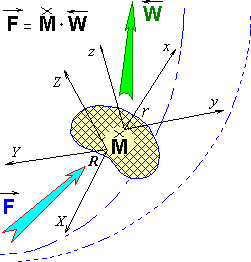 The stratification of computational
processes by the physical parameters is set into the tensor definition of fluidmechanics
laws basis, when external forces and reactions summoned by them should be defined by
different tensor bases (coordinate systems). Invariants and eigenvectors of such the
tensor of connection between the bases define the internal reological properties of liquid
particle and the accumulation factors (closing) inside of the external energy. Principles
of the computational operations within the tensor area are fundamental laws of mechanics
which give strict description of the reological and dynamics flow properties.
The stratification of computational
processes by the physical parameters is set into the tensor definition of fluidmechanics
laws basis, when external forces and reactions summoned by them should be defined by
different tensor bases (coordinate systems). Invariants and eigenvectors of such the
tensor of connection between the bases define the internal reological properties of liquid
particle and the accumulation factors (closing) inside of the external energy. Principles
of the computational operations within the tensor area are fundamental laws of mechanics
which give strict description of the reological and dynamics flow properties.
In particular within the fluid flow area where the degeneration of II-range tensor
basis, is taking place – practically might be observed the vortex, free surface
separation or cavity. Respectively control of a conditionality of the matrix which is
forming the tensor of the fluid properties might allow as to provide the authenticity of
computational experiments, so to carry out a opportune transfer to particular problems or
others including empirical patterns.
It is interesting that using formal tensor laws which are applied for “viscous
compressible either” it is easy to determine the elementary particles including ones
which take part in dynamics of intranuclear substance reciprocity; by the same positions
to define thermal, electromagnetic, mechanical and gravitational fields and reciprocity
principles of the physical objects.
The instrument for tensor laws construction might be used for computational processes
design of evident (canonic) form that might provide the parallel computational processes
till the each of a single fluid particle and also it sets conditions for automatic
reconstruction of computational schemes possibility, depending on the current fluid
mechanics or flow reology properties.
Mathematical and computational simulation of tidal
and flow in Okhotsk sea
Okhotsk sea is a large half-closed water area, and it is unique region
for a natural and computational researching for the tidal and flow processes.
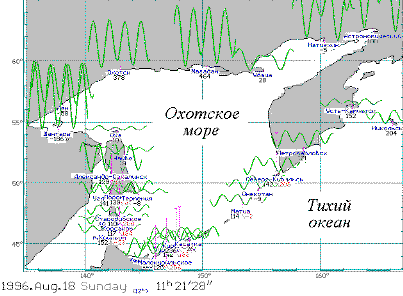 The target of the current project is
creation of mathematical models and realization of oceanological computational experiments
which is capable to simulate the real tidal and flow conditions in the Okhotsk sea and
also to predict simulate off storm surge and tsunami.
The target of the current project is
creation of mathematical models and realization of oceanological computational experiments
which is capable to simulate the real tidal and flow conditions in the Okhotsk sea and
also to predict simulate off storm surge and tsunami.
Project goals to study the numerical scheme properties, to analyze the empirical
dependencies which are characterizing the bottom friction, surface strains from storm
winds and other dynamic and algorithmic particularities of computational simulation for
tidal and flow. As results of the performance mathematical models and their program
realizations would be created and tested in which peculiarities of the fluid mechanics
processes simulation in the Okhotsk sea would be taken into account, and procedures and
criterion for the direct numerical simulation of the tidal modes within other half-closed
seas would be elaborated.
The project was supported by Russian Foundation for Basic Researches,
grant ¹ 97.05.66037
Compute aided system for duty oceanologist
of the tsunami warning service
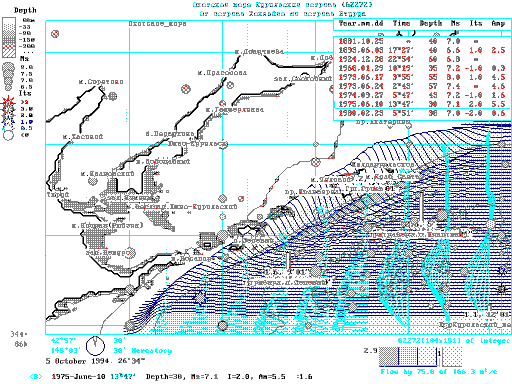
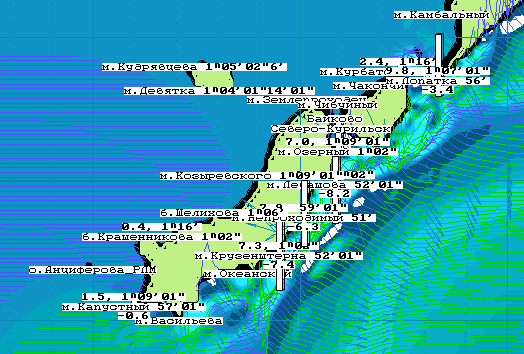
The tsunami is dangerous sea phenomena, which admits the possibility to organize the actions for the peopling
evacuation with the lead time from a few minutes to hours.
Fluid mechanics of tsunami shall be defined as high-frequency long wave
process, the direct numerical simulation of which requests the large computational
resources to meet the approximation criterion.
The current project solves the problem for complex researches of
special information systems and computational experiments which have to be adapted for
operative information receiving from coastal hydrometeorological stations observation and
to carry out in full accordance to operational tsunami warning service regulations.
The project was supported by Russian Foundation for Basic Researches,
grant ¹ 97.01.96010.
(Kamchatka)
Navigator’s on board compute systems for the
oil-rig steadfast and stability
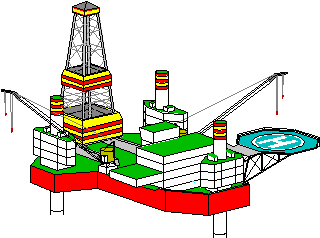 Drilling on the
Sakhalin shelf perform during the summer navigation. In autumn oil-rigs returning to south
area of the Okhotsk sea and while they are going over a sea they risk to come upon the
force of the hurricane storms. When the storm rolling the oilrig captain has an optimal
solving from contradict conditions between decreasing of upper deck flooding and
minimization of rolling and angle acceleration on rolling and pitching
Drilling on the
Sakhalin shelf perform during the summer navigation. In autumn oil-rigs returning to south
area of the Okhotsk sea and while they are going over a sea they risk to come upon the
force of the hurricane storms. When the storm rolling the oilrig captain has an optimal
solving from contradict conditions between decreasing of upper deck flooding and
minimization of rolling and angle acceleration on rolling and pitching
It is proposed to automatize all the navigator’s calculations related with
estimations of loading, stability, rolling and rolling parameters of the oilrig.
Navigator’s computer must be connect with the data units of wind velocity and
direction, data from compass and inclinometer. Such the computer unit will allow in
automatic mode to control the seakeeping and safety conditions on the storm ways, and will
allow in a short time to estimate different options for rig loading, which will be
promoting for decreasing of the dangerous effect of the storm wind and clean breach.
The analogous work modes of the navigator’s computer should provide the steady of
oilrig being on the ground, when during the oil production process the loading modes as
alternate, that the static steady of the rig might be broken under the effects of stream,
storm and waving.
Onboard seakeeping computer system
 The navigator’s information
computational complex should include a computer which will receive the information from
navigational instruments: compass, velocity log, echo depth sounder, gyro-compass, GPS and
data units of main engines, from a weather system the water and air temperature, wind
direction and velocity, wave height characteristics. In that case with the help of
computational algorithms for the proper rolling and ship stability parameters might be
identified using previous records of storm navigating mode; the recommendations about
maximum speed achievement methods, minimizing of rolling and other seakeeping
characteristics required by duty navigator would be elaborating.
The navigator’s information
computational complex should include a computer which will receive the information from
navigational instruments: compass, velocity log, echo depth sounder, gyro-compass, GPS and
data units of main engines, from a weather system the water and air temperature, wind
direction and velocity, wave height characteristics. In that case with the help of
computational algorithms for the proper rolling and ship stability parameters might be
identified using previous records of storm navigating mode; the recommendations about
maximum speed achievement methods, minimizing of rolling and other seakeeping
characteristics required by duty navigator would be elaborating.
Such work has the most important fundamental value for researching the seaworthiness
problems will allow to rise the level of navigation convenience and security, will allow
to enlarge the ship operation efficiency during the storm sailing.
Storm seakeeping researching agreed the hull form
and the ship architecture
Seakeeping of the ship is a researches depend on the really marine
practice and on the human experience based on the captain’s solving for a different
seagoing conditions. Project concludes the following three parts:
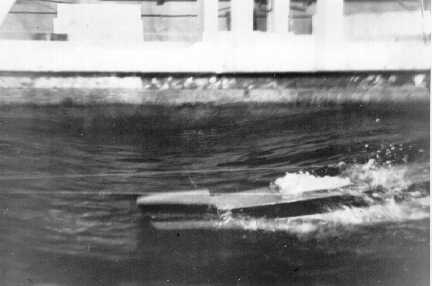 1. The analysis of the historical
decisions at designing the most seaworthy form of the case of the ship, comparison to
modern experience of navigation and seafaring.
1. The analysis of the historical
decisions at designing the most seaworthy form of the case of the ship, comparison to
modern experience of navigation and seafaring.
2. Complex of analytical researches and computing experiments, which make a theoretical
basis of designing by best on seaworthy qualities of the form of the case of the ship;
3. Complex of seaworthy tests in the towing basin, when for an estimation of critical
modes of navigation, in common with the special prepared experimental model the tests of
base models were carried out, on which in the world literature there are extensive items
of information. In conclusion of experiments the tests of modes of safe navigation were
executed, in which the model was tested on the supercritical for a traditional vessel
regimes of sailing and safety of emergency swimming without a course.
The work requires recurrence of all computing experiments with use of modern computer
facilities, and also which contain in detailed study of experimental records on paper
carriers, speed up and calibrate curves, indications of accelerometer, gyro-horizon and
wavegraphs, complex tests, received at performance in the towing basin.
By results of computing experiments and towing tests the qualitative conclusions about
an opportunity of essential improvement of seaworthy qualities of the ship adapted to
navigation in a storm condition were received thus, practically in all modes of storm
navigation the new model showed the essential superiority over the existing projects of
the form of the case of the ship.
§ 1. Technician-history analysis of ship
seakeeping
(c)85-98, Vasily N. Khramushin, Saint-Petersburg - Yuzhno-Sakhalinsk
Information complex for analysis of operative
hydrometeorological environment at the sea
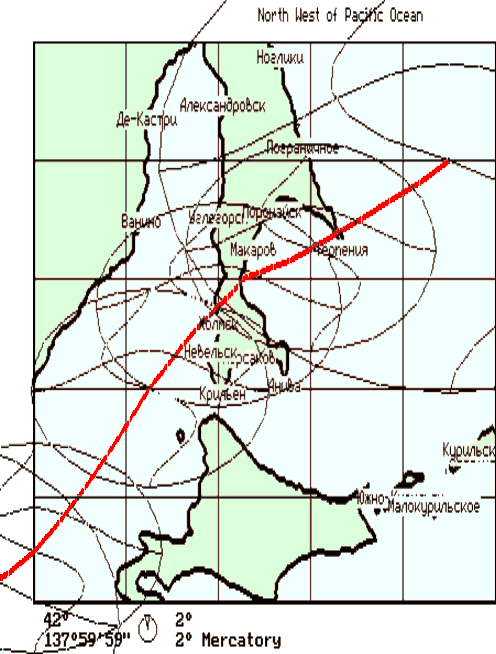 The performance of
the current project is necessary for technical improvement of the tool facilities using in
the Sea Department, hydro-forecast services and in the Tsunami Warning Center of the
Sakhalin Hydrometeorology service.
The performance of
the current project is necessary for technical improvement of the tool facilities using in
the Sea Department, hydro-forecast services and in the Tsunami Warning Center of the
Sakhalin Hydrometeorology service.
The topicality of project is specified by the point that present services carry out
using obsolete paper technologies which it is impossible to use for efficient solution to
the operative problems related with the sea environment control.
During automation process of the routing tasks in sea departments of the Sakhalin
Weather Service the formats of data and operative information should be developed which at
further time might be used at performance the oceanological researches involving
international projects.
 The stratification of computational
processes by the physical parameters is set into the tensor definition of fluidmechanics
laws basis, when external forces and reactions summoned by them should be defined by
different tensor bases (coordinate systems). Invariants and eigenvectors of such the
tensor of connection between the bases define the internal reological properties of liquid
particle and the accumulation factors (closing) inside of the external energy. Principles
of the computational operations within the tensor area are fundamental laws of mechanics
which give strict description of the reological and dynamics flow properties.
The stratification of computational
processes by the physical parameters is set into the tensor definition of fluidmechanics
laws basis, when external forces and reactions summoned by them should be defined by
different tensor bases (coordinate systems). Invariants and eigenvectors of such the
tensor of connection between the bases define the internal reological properties of liquid
particle and the accumulation factors (closing) inside of the external energy. Principles
of the computational operations within the tensor area are fundamental laws of mechanics
which give strict description of the reological and dynamics flow properties. The target of the current project is
creation of mathematical models and realization of oceanological computational experiments
which is capable to simulate the real tidal and flow conditions in the Okhotsk sea and
also to predict simulate off storm surge and tsunami.
The target of the current project is
creation of mathematical models and realization of oceanological computational experiments
which is capable to simulate the real tidal and flow conditions in the Okhotsk sea and
also to predict simulate off storm surge and tsunami.

 Drilling on the
Sakhalin shelf perform during the summer navigation. In autumn oil-rigs returning to south
area of the Okhotsk sea and while they are going over a sea they risk to come upon the
force of the hurricane storms. When the storm rolling the oilrig captain has an optimal
solving from contradict conditions between decreasing of upper deck flooding and
minimization of rolling and angle acceleration on rolling and pitching
Drilling on the
Sakhalin shelf perform during the summer navigation. In autumn oil-rigs returning to south
area of the Okhotsk sea and while they are going over a sea they risk to come upon the
force of the hurricane storms. When the storm rolling the oilrig captain has an optimal
solving from contradict conditions between decreasing of upper deck flooding and
minimization of rolling and angle acceleration on rolling and pitching The navigator’s information
computational complex should include a computer which will receive the information from
navigational instruments: compass, velocity log, echo depth sounder, gyro-compass, GPS and
data units of main engines, from a weather system the water and air temperature, wind
direction and velocity, wave height characteristics. In that case with the help of
computational algorithms for the proper rolling and ship stability parameters might be
identified using previous records of storm navigating mode; the recommendations about
maximum speed achievement methods, minimizing of rolling and other seakeeping
characteristics required by duty navigator would be elaborating.
The navigator’s information
computational complex should include a computer which will receive the information from
navigational instruments: compass, velocity log, echo depth sounder, gyro-compass, GPS and
data units of main engines, from a weather system the water and air temperature, wind
direction and velocity, wave height characteristics. In that case with the help of
computational algorithms for the proper rolling and ship stability parameters might be
identified using previous records of storm navigating mode; the recommendations about
maximum speed achievement methods, minimizing of rolling and other seakeeping
characteristics required by duty navigator would be elaborating. 1. The analysis of the historical
decisions at designing the most seaworthy form of the case of the ship, comparison to
modern experience of navigation and seafaring.
1. The analysis of the historical
decisions at designing the most seaworthy form of the case of the ship, comparison to
modern experience of navigation and seafaring. The performance of
the current project is necessary for technical improvement of the tool facilities using in
the Sea Department, hydro-forecast services and in the Tsunami Warning Center of the
Sakhalin Hydrometeorology service.
The performance of
the current project is necessary for technical improvement of the tool facilities using in
the Sea Department, hydro-forecast services and in the Tsunami Warning Center of the
Sakhalin Hydrometeorology service.